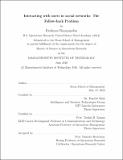| dc.contributor.advisor | Danelle Shah and Tauhid R. Zaman. | en_US |
| dc.contributor.author | Rajagopalan, Krishnan, S.M. Sloan School of Management | en_US |
| dc.contributor.other | Massachusetts Institute of Technology. Operations Research Center. | en_US |
| dc.date.accessioned | 2016-10-25T19:17:57Z | |
| dc.date.available | 2016-10-25T19:17:57Z | |
| dc.date.copyright | 2016 | en_US |
| dc.date.issued | 2016 | en_US |
| dc.identifier.uri | http://hdl.handle.net/1721.1/105000 | |
| dc.description | Thesis: S.M., Massachusetts Institute of Technology, Sloan School of Management, Operations Research Center, 2016. | en_US |
| dc.description | This electronic version was submitted by the student author. The certified thesis is available in the Institute Archives and Special Collections. | en_US |
| dc.description | Cataloged from student-submitted PDF version of thesis. | en_US |
| dc.description | Includes bibliographical references (pages 69-71). | en_US |
| dc.description.abstract | An agent wants to form a connection with a predetermined set of target users over social media. Because forming a connection is known as "following" in social networks such as Twitter, we refer to this as the follow-back problem. The targets and their friends form a directed graph which we refer to as the "friends graph." The agent's goal is to get the targets to follow it, and it is allowed to interact with the targets and their friends. To understand what features impact the probability of an interaction resulting in a follow-back, we conduct an empirical analysis of several thousand interactions in Twitter. We build a model of the follow-back probabilities based upon this analysis which incorporates features such as the friend and follower count of the target and the neighborhood overlap of the target with the agent. We find optimal policies for simple network topologies such as directed acyclic graphs. For arbitrary directed graphs we develop integer programming heuristics that employ network centrality measures and a graph score we define as the follow-back score. We show that these heuristic policies perform well in simulation on a real Twitter network. | en_US |
| dc.description.statementofresponsibility | by Krishnan Rajagopalan. | en_US |
| dc.format.extent | 71 pages | en_US |
| dc.language.iso | eng | en_US |
| dc.publisher | Massachusetts Institute of Technology | en_US |
| dc.rights | M.I.T. theses are protected by copyright. They may be viewed from this source for any purpose, but reproduction or distribution in any format is prohibited without written permission. See provided URL for inquiries about permission. | en_US |
| dc.rights.uri | http://dspace.mit.edu/handle/1721.1/7582 | en_US |
| dc.subject | Operations Research Center. | en_US |
| dc.title | Interacting with users in social networks : the follow-back problem | en_US |
| dc.type | Thesis | en_US |
| dc.description.degree | S.M. | en_US |
| dc.contributor.department | Massachusetts Institute of Technology. Operations Research Center | |
| dc.contributor.department | Sloan School of Management | |
| dc.identifier.oclc | 960814740 | en_US |
